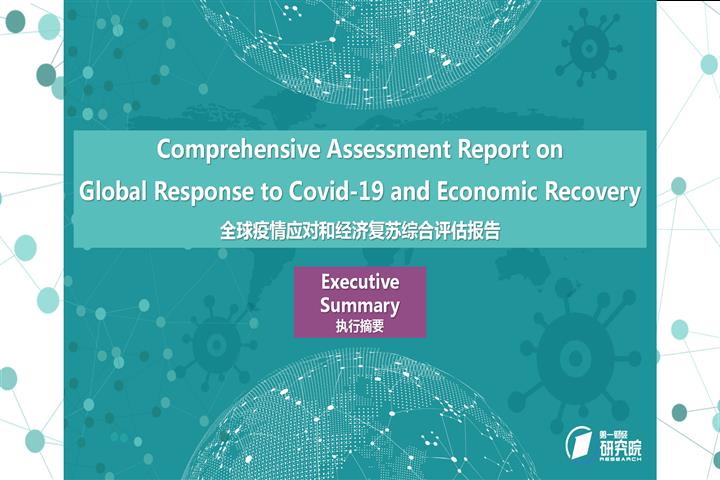 Comprehensive Assessment and Ranking Report on the Response to the Covid-19 Pandemic and Economic Recovery of 108 Economies
Comprehensive Assessment and Ranking Report on the Response to the Covid-19 Pandemic and Economic Recovery of 108 EconomiesOctober 2020
Contents
1. Methodological Framework
2. Selection of Sample Countries
3. Ranking Results
4.Containing Covid-19
5. Economic Bailout
6. Economic Reboot and Recovery
7. International Cooperation
Executive Summary
The Covid-19 pandemic and the resulting economic recession have made 2020 a year to remember for the entire world, comparable to the flu pandemic in 1918 and the Great Depression from 1929 to 1933. The situation is likely to continue next year and even for years to come.
The novel coronavirus has posed unprecedented challenges to the global economy. A set of policy mix, including social distancing, quarantine, tracking and contact tracing, etc., have been phased in, although in various degree of strictness in economies that has been hit by Covid-19 to curb the spread of the virus. Policy makers also have implemented massive scale of fiscal and monetary stimulus to bail out the economy as a result of lockdown. Major economies have reopened since May before getting the virus completely under control, which has resulted in a rebound in new cases, a return to record highs and second wave make the global fight against Covid-19 even more complicated.
Covid-19 continues to spread around the world at an even more speedy rate today. Some countries are experiencing a second wave and some have never reached a turning point. Some 38,426,373, people worldwide had been infected as of 10.00 a.m. on Oct. 15(Beijing time), which translates into 51 infections for every 10,000 people.
Global economy suffered the greatest economic recession on record in the second quarter of 2020. According to the latest WEO report of IMF, world output will suffer 4.4% loss in 2020, with advanced economies and emerging market/developing economies shrinking 5.8% and 3.3% respectively. Moreover, Covid-19 has claimed 1,091,245 lives worldwide as of 10.00 a.m. on Oct. 15(Beijing time), which equals to 14 deaths for every 100,000 people. Secondary disasters from the pandemic continue to unfold and Covid-19 is bringing about fundamental changes to the whole world, what the post Covid-19 world will look like depends on the actions and reactions that policy-makers and people have chosen today.
Yicai Research Institute have compiled an assessment and ranking system jointly with Yicai Global and the Pan-Asia Research Institute of Digital Economy, using 23 detailed indicators to evaluate the performance of 108 countries in handling the Covid-19 pandemic and their economic recoveries. It is hoped that this report will shed some light on “best practices” and provide references for policy makers of the whole world in combating the Covid-19 pandemic, fostering economic recovery as well as adapting to the medium- and long-term structural changes.
1. Methodological Framework
We assessed countries’ handling of the pandemic and their economic recovery in the Level I Index which looks at the response to Covid-19, economic bailout measures and the degree of international cooperation.
The above three Level I Indexes plus the Level II, Level III and Level IV Indexes constitute our assessment system. The weight of each index is decided based on the absolute results of studying pandemic control measures and respecting the data. The detailed indexes and their weights are listed in the following table. The pandemic and public economic data are as of Aug. 31.
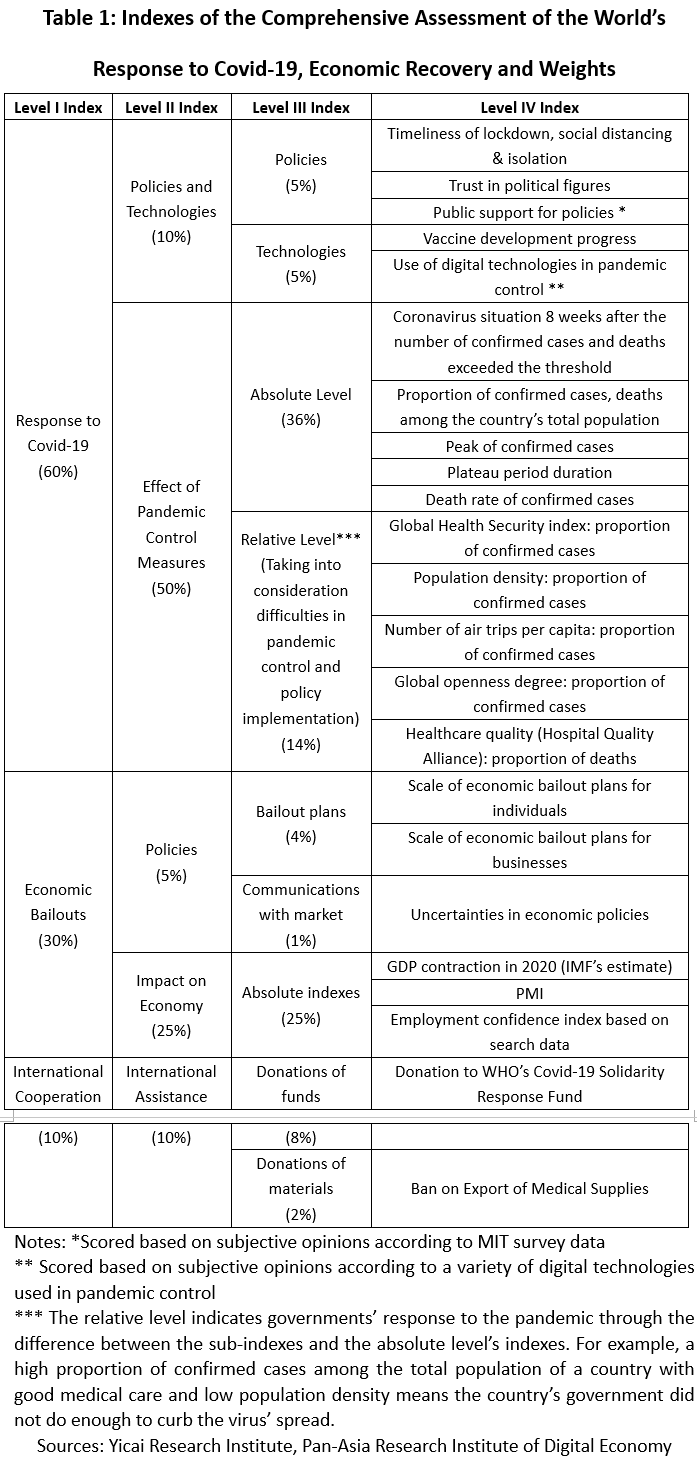
2. Selection of Sample Countries
Taking into account that the pandemic started in different countries at different times, we chose those countries with over 100 confirmed cases and more than 10 deaths as of June 30 to ensure data availability and to assess as many countries as possible.
3. Ranking Results
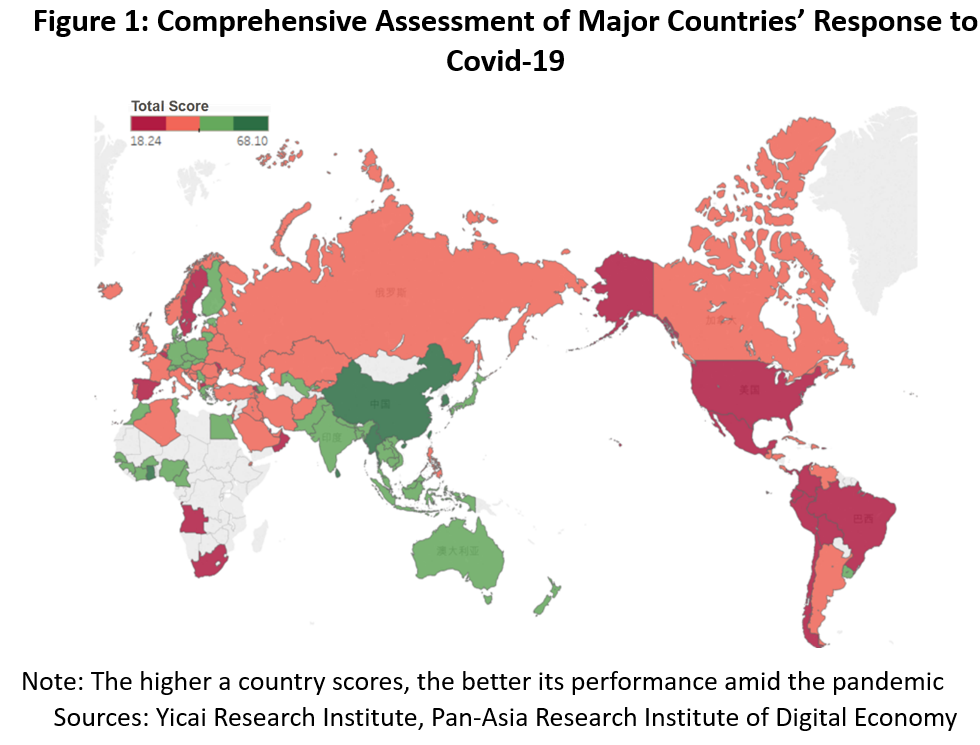
Using these criteria, we selected 108 countries covering the majority of the world’s regions and population to assess their response to the virus and their economic recovery. Figure1 shows the performance of major countries and regions, and Table 2 specifies the rankings and scores of each country. Not surprisingly, Asia-Pacific countries performed particularly well. China topped the list. South Korea ranked fourth despite the recent new outbreaks of the epidemic. Sri Lanka, Myanmar, Thailand, Vietnam and Cambodia as well as Australia and New Zealand all ranked among the top 10. The best performers in Europe were Denmark and Germany in 21st and 23rd place respectively. Austria, Greece and Switzerland also performed well. Unsurprisingly, the US and Brazil, both countries with leaders who initially downplayed the problem and with a lack of public support for the government’s policies, came 98th and 89th respectively. Sweden, one of the very few countries to opt for the controversial tactic of herd immunity, ranked 90th.
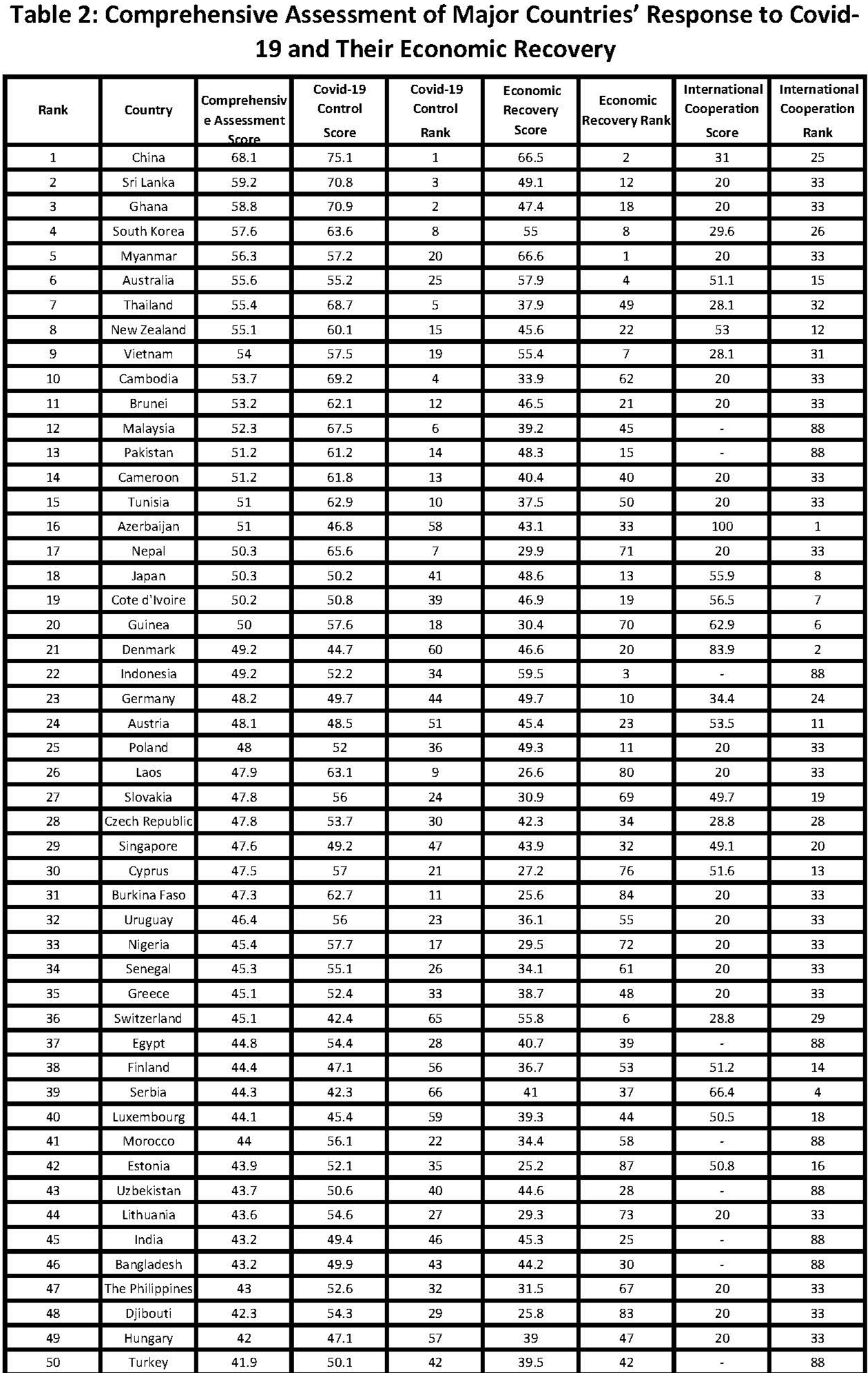
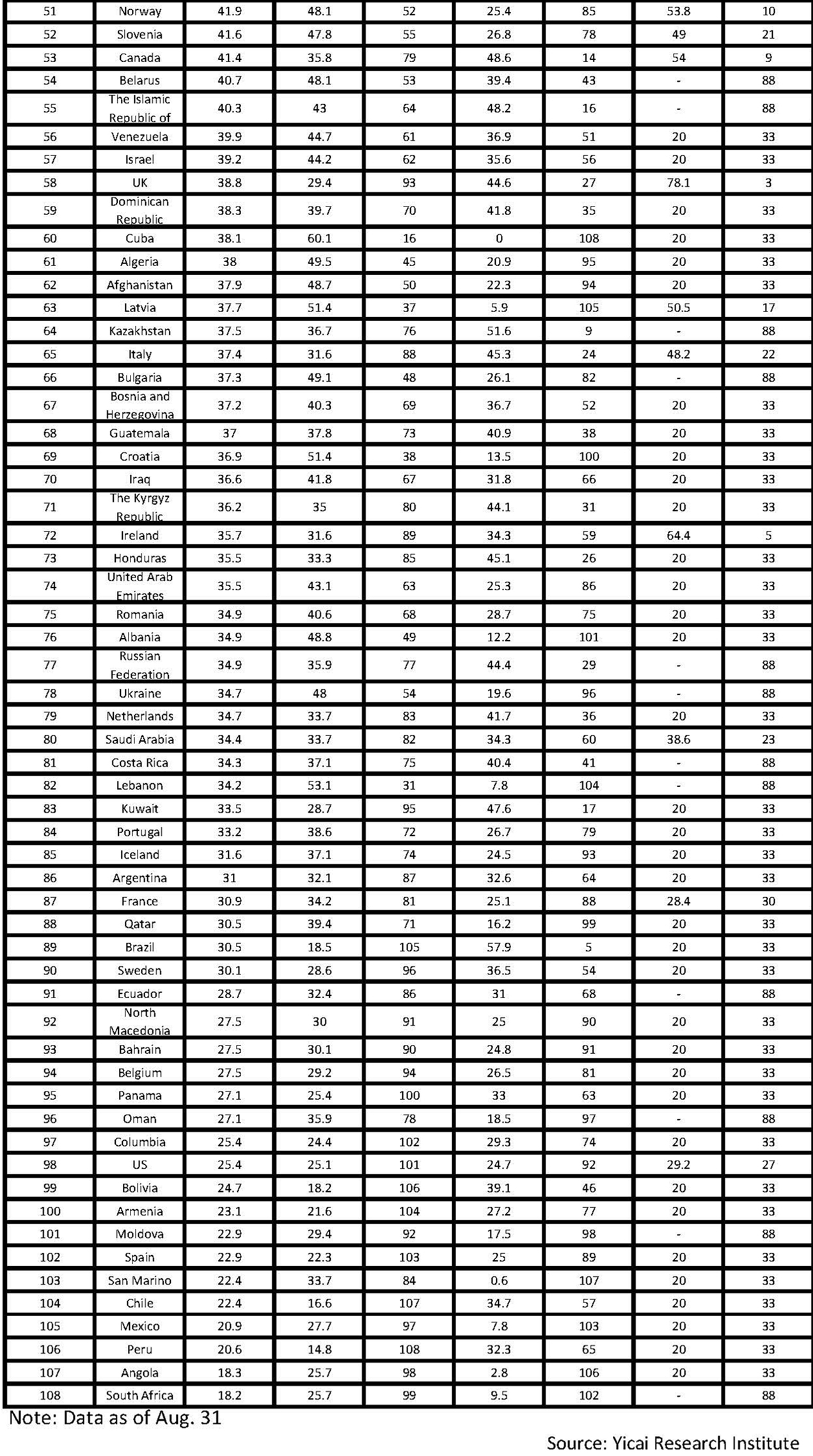
The Yicai Research Institute used the SEIR epidemiological model, as well as our self-developed “social network-based virus transmission model “ to predict the state of the pandemic in different nations. The SEIR model, classing people as either Susceptible, Exposed, Infectious or Removed,’ which assumes that asymptomatic cases are always present and bases its calculations on earlier disease trajectories, showed that countries with strict epidemic prevention policies, such as China, South Korea and Italy, all had the pandemic under control and logged R0 (Basic Reproduction Number ) lower than 1 in July. The social network-based model, which assumes that the regional increase of Covid-19 cases constitutes a new outbreak of the pandemic, showed that those countries that had the outbreak under control in its early stages and then saw new clusters emerge that results to R0 bigger than 1 in July, indicating that consistent epidemic prevention and control measures are essential.
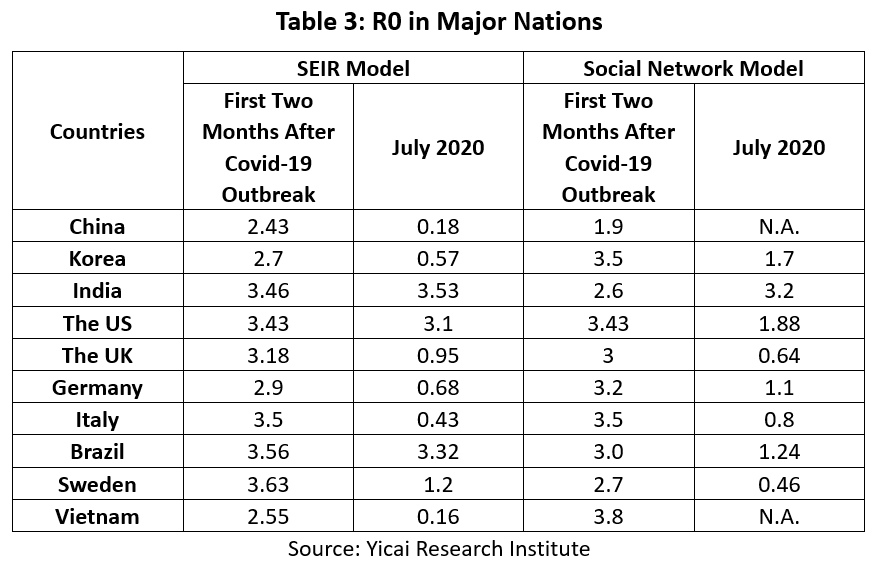
Public health infrastructure, population density and population mobility vary from country to country which means each country faces a different set of challenges in its fight against the pandemic. We used the aircraft passenger database compiled by the International Air Transport Association to make the evaluation’s results more rational and to take population mobility as a gauge. This database includes all air travel statistics (both between and within countries) throughout 2018. We used it as a baseline to compare with the collective number of confirmed Covid-19 cases in various nations that the World Health Organization made public (as of Aug. 31).
We calculated the proportion of global air passenger volume to the overall number of confirmed Covid-19 cases in each nation. The correlation coefficient of these two figures was 0.66, which means the proportion of a country’s global air passenger volume accounts for about two-thirds of its total confirmed cases. For instance, Italy’s proportion of global air passenger volume reached 0.67 percent, and the number of its confirmed Covid-19 cases was 1.09 percent as of Aug. 31.
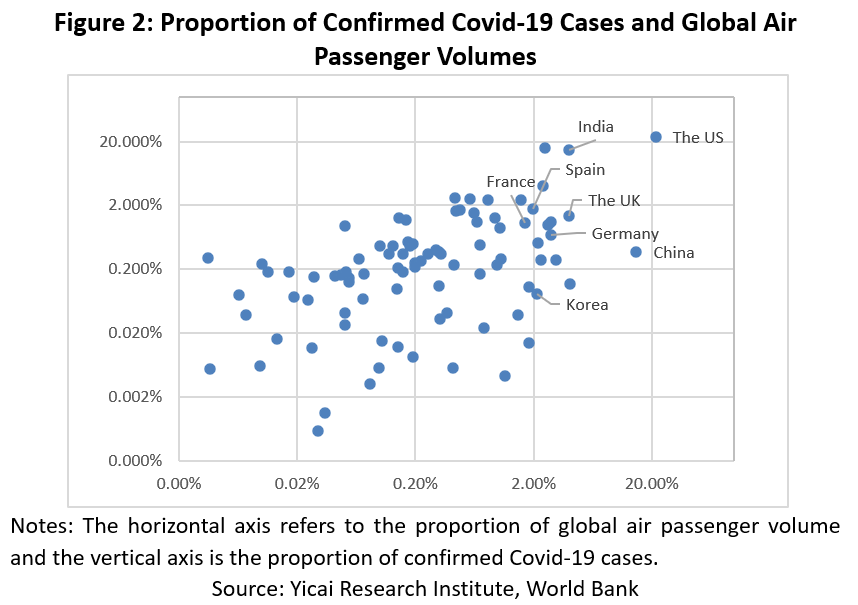
Nations’ efforts in the fight against Covid-19 can be compared once the baseline for measuring the novel coronavirus infection is determined. The method we adopted was to ‘calculate Covid-19 gaps,’ which is the proportion of global air passenger volume in 2018 minus the corresponding proportion of confirmed Covid-19 cases. A ‘positive’ gap means the country performed better than the benchmark level in the prevention and control of Covid-19. Brazil had the largest negative gap at minus 13.14 percent, indicating that the disease’s infection rate exceeded the projection we could make using air passenger data. China boasted the biggest positive gap at 14.46 percent, showing that we did achieve some success regarding the prevention of the virus’ spread, and the ranking corresponded with the evaluation’s results.
Strict and all-encompassing social distancing and quarantine measures can quickly eliminate the virus’ transmission routes. The possibility of adopting such measures worldwide, however, is very small. Under pressure, some nations restarted their economy in May before the Covid-19 pandemic was completely under control. The aim should be to prevent repeated, large-scale outbreaks of the disease while enabling a stable economic recovery. This should prevent the occurrence of secondary disasters including ‘bank runs’ for medical resources. Effective testing, tracking and tracing are also needed so as to reboot the economy in an orderly way.
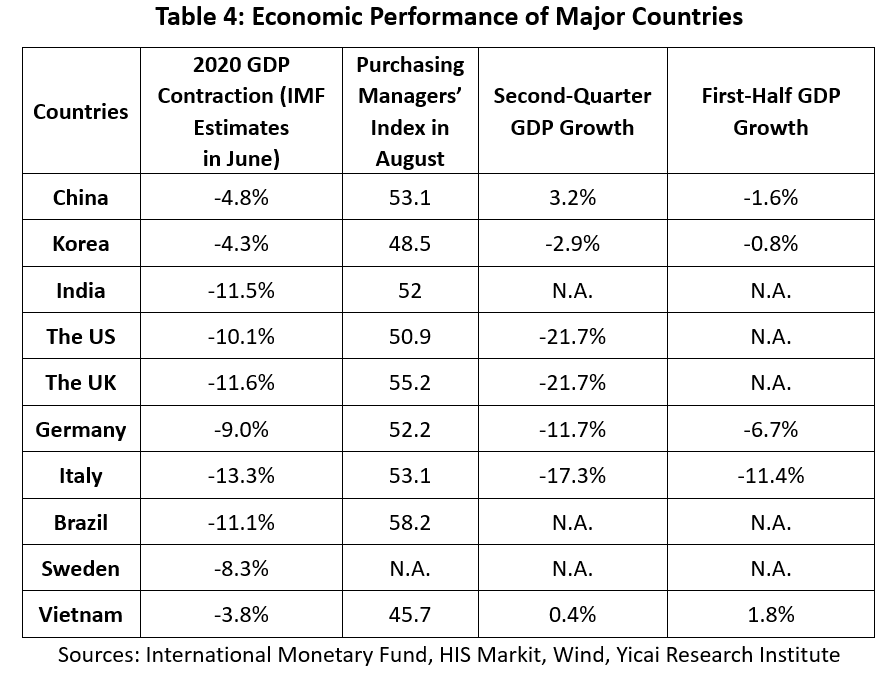
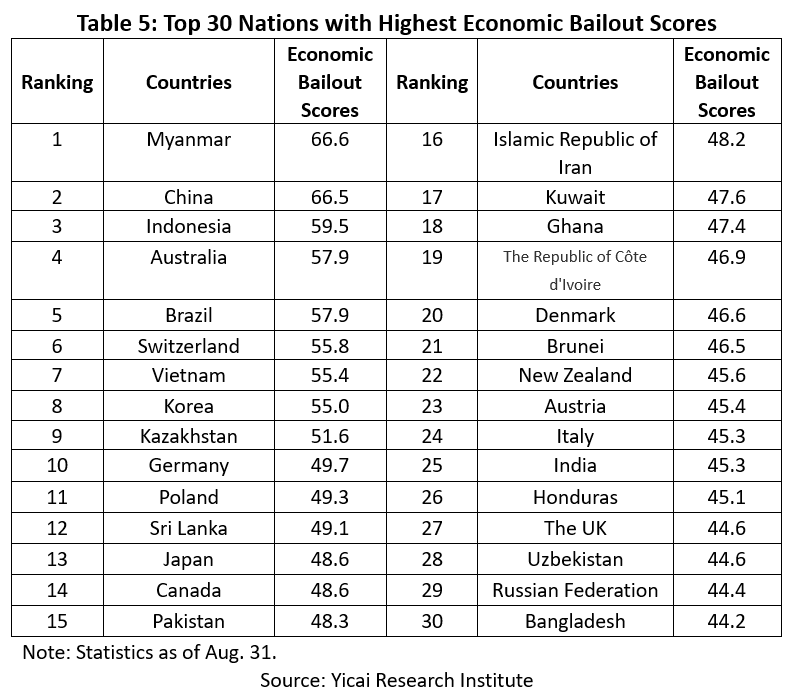
Myanmar scored the most points in terms of economic bailouts, while China, Australia, Korea, Germany, Japan and Canada were all in the top 15 places. Asian countries in general performed well.
The purchasing managers’ indexes of major economies already began to expand in September, according to the latest economic data. China and Korea, which were able to get the pandemic under control at an early stage, had a smaller economic decline in the first half. The economic performance of major nations shows that curbing the spread of Covid-19 is the key to economic recovery.

4. Containing Covid-19
The measures that mankind has taken to deal with Covid-19 are identical to those used during previous epidemics. Controlling population mobility and preventing cross infection remain the most effective means to curb the further spread of the disease.
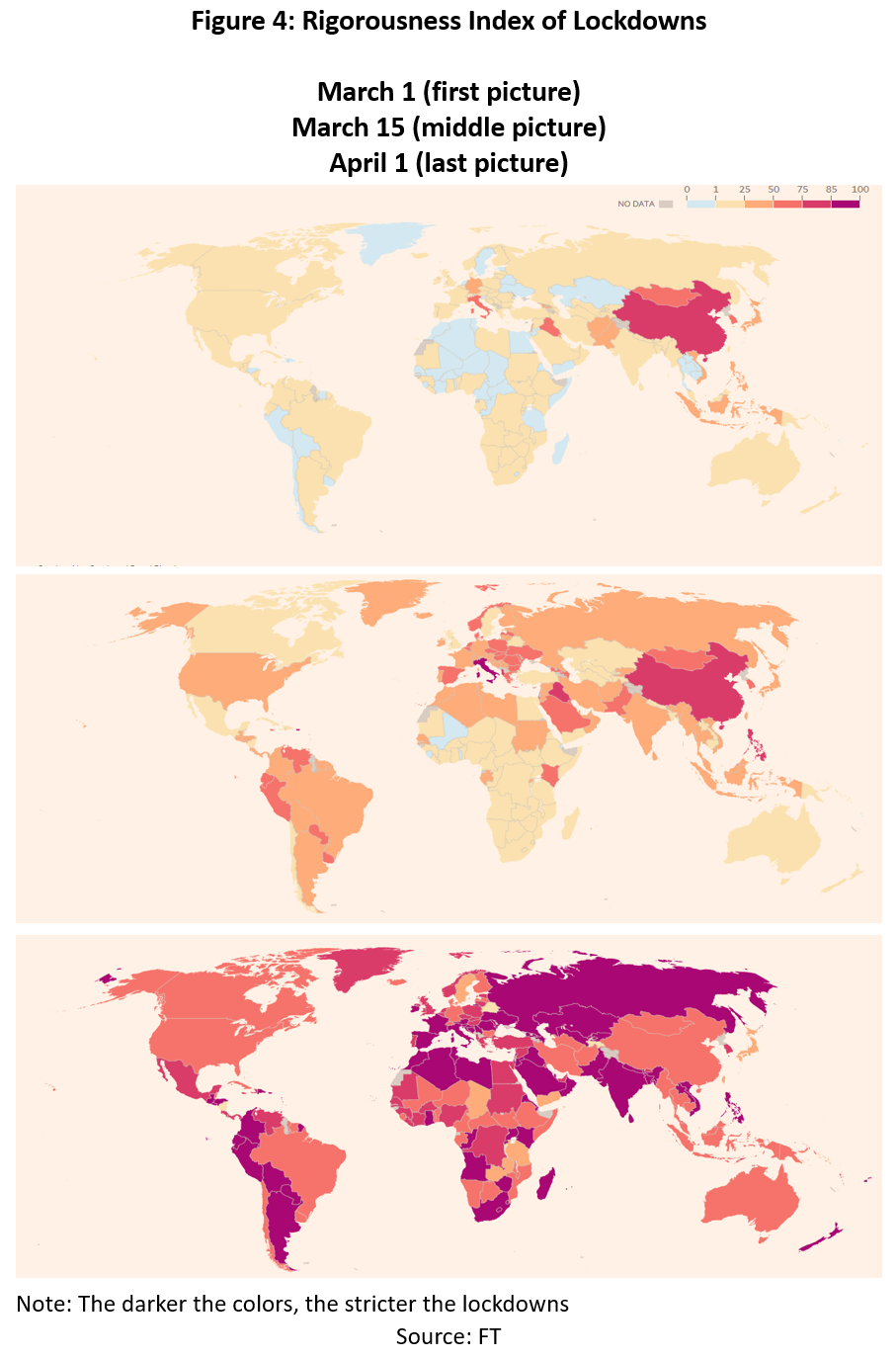
Most countries have implemented ‘Suppression’ measures in the hope of preventing the virus’ spread by restricting activities and encouraging social distancing and quarantine. However, the specific measures and the timing and degree of their implementation have varied.
China was the first country to conduct curbing measures, according to the rigorousness index of lockdowns compiled by the UK’s Financial Times. Other Asian nations, including South Korea and Vietnam, also carried out large-scale prevention measures. European, North American and African nations were rather late in bringing in strict suppression measures and some of their policies were not carried out in full. For instance, only some states in the US conducted lockdowns and the US had looser restrictions on social distancing and quarantine on April 1, compared with those applied in major developed nations in Western Europe which were also encountering a Covid-19 outbreak.
Many countries succumbed to economic pressure and kickstarted their economy when the pandemic was not yet under control and the number of new cases was still peaking. New Covid-19 cases have been on the rise since the global economic restart in early May. The number of new cases per week reached round 1.8 million people as of the end of August, more than triple that of the 550,000 per week at the beginning of May.
The results of our evaluation show that Covid-19 infection rates (or the proportion of confirmed cases among the whole population) of the countries that gained higher scores in terms of pandemic prevention work are generally very low, including China and South Korea, despite the rapid spread of Covid-19 across the world.
Asia, as a whole, achieved a noticeably good performance in the fight against Covid-19. Eight of the top 10-ranked countries were on the continent, with China and South Korea in 1st and 8th place respectively. Another major economy that did well in terms of pandemic prevention was Australia, which ranked 25th.
The low infection rate has to some degree flattened the curve of the pandemic and lowered the peak number of cases in order to enable healthcare systems to ‘trade time for space.’ This allows hospitals and clinics to get ready to receive critically-ill patients to avoid ‘bank runs’ on healthcare resources and prevent the tragedy of death should a great number of patients not be able to receive treatment in time. Such ‘bank runs’ happened during the early stages of the Covid-19 outbreak in Italy. A huge number of medical staffers were infected due to inadequate medical supplies, which intensified the lack of medical resources, making the death rate in Italy rise far above the global average. The lives that were lost are an irretrievable loss to human society. This is also the absolute cost that the world’s nations have to pay amid their fight against Covid-19. Reducing the peak, or ‘flattening the sombrero,’ can effectively lower the death rate.
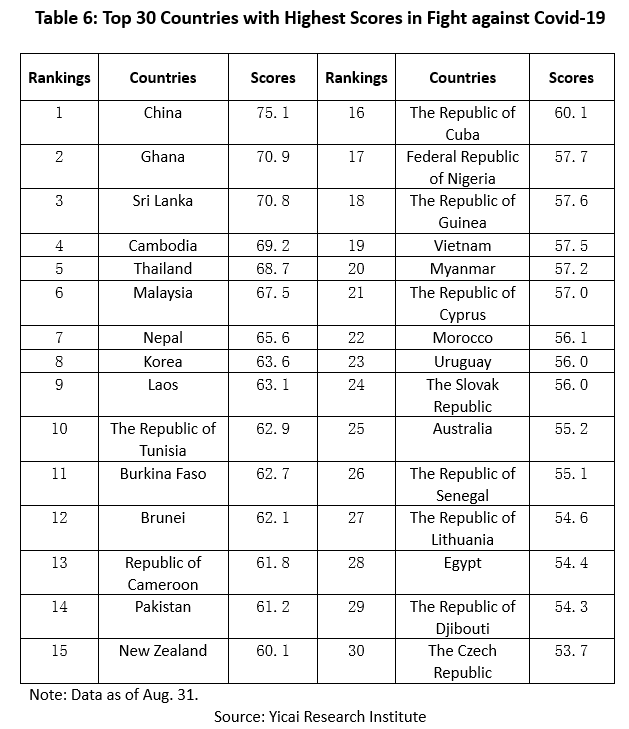
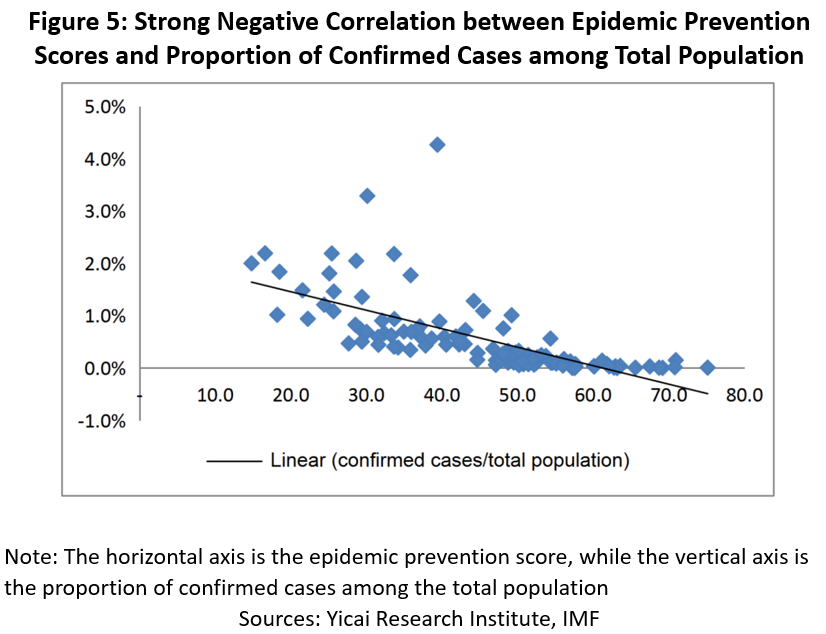
Our assessment shows that the timely introduction of epidemic prevention policies by governments, together with a good degree of cooperation from the public, is key to quickly stopping the spread of the disease.
Once more than 100 cases have been confirmed, it becomes a critical point in the epidemic’s transmission. The sooner the government imposes social distancing measures, the easier it is to control the outbreak. However, if citizens are unwilling to cooperate or even distrust the government, then even the swift introduction of social distancing measures cannot achieve good results. To take Brazil as an example, it implemented social distancing measures as early as March 12, at the same time as some major European countries. But Brazil had a much higher proportion of confirmed cases than these European countries by the end of August. The president refused to wear a mask outside and epidemic control measures were significantly impacted by disagreements between the central and local governments. If a country performs poorly in these two aspects, with the late announcement of social distancing measures and the limited implementation of epidemic control measures (such as people refusing to wear masks), the spread of the disease can be even worse than in countries with 'herd immunity' such as Sweden. This is the situation that the US finds itself in.
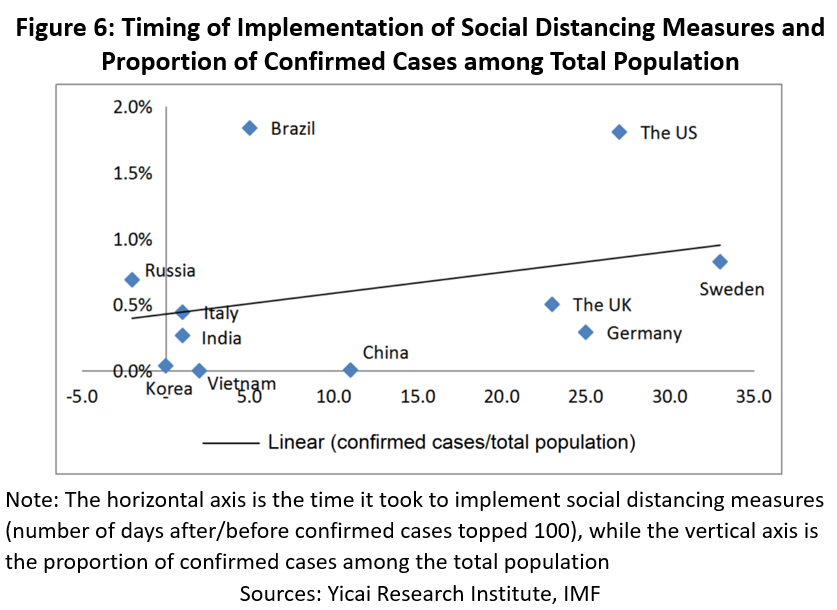
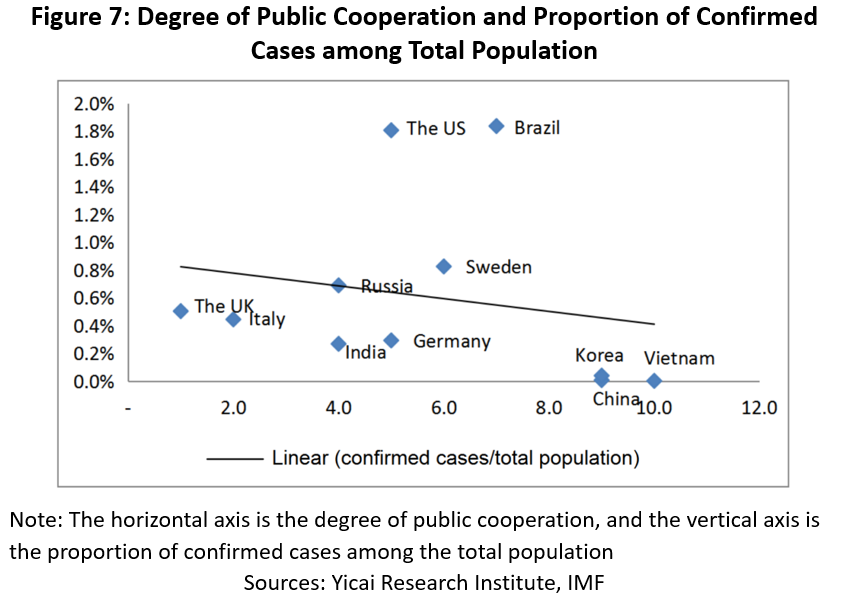
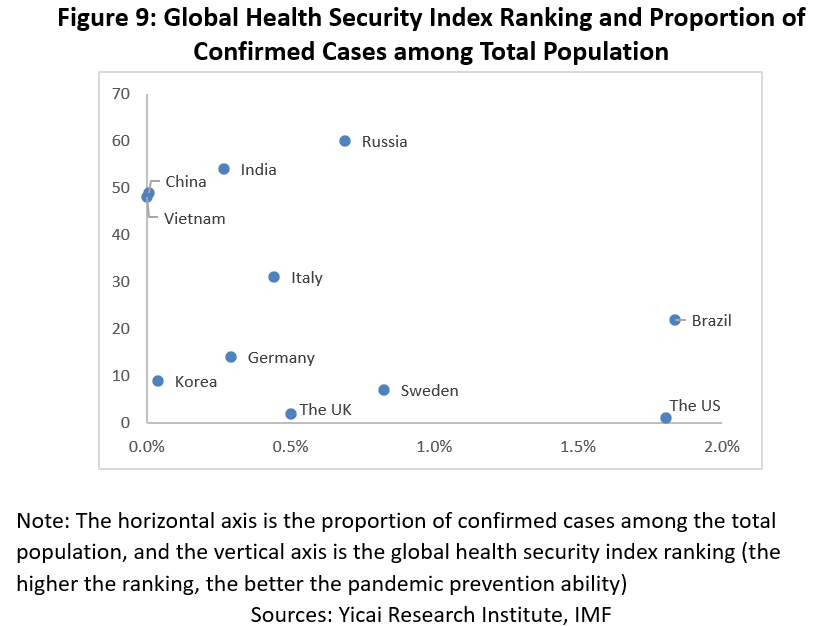
More governments are beginning to actively explore the use of digital technology in the fight against the epidemic. In the early stages, some countries used digital technology to fight the epidemic and achieved positive results. For example, China uses a so-called 'QR health code' and South Korea uses a mobile app to remind quarantined people not to leave designated areas. If operators detect someone crossing the line, a text message will be sent to inform the person and he/she will be reported to the relevant department. It can be said that precise social distancing based on digital technology is an important part of both China’s and the South Korean fight against the epidemic.
Personal location data can be highly sensitive. People worry about the abuse of personal privacy data. Tracking apps' frequent use of personal privacy data blurs the line between privacy protection and ensuring public health security. The European Commission released the 'Guidance on Apps Supporting the Fight Against the Covid-19 Pandemic in Relation to Data Protection' in April to ensure that citizens' personal data is adequately protected when they use the apps, so as to increase public trust in innovative applications and ensure maximum participation by citizens.
Our assessment shows that developed countries in the West that had a higher rank on the global health security index generally lagged behind East Asian and some Southeast Asian countries on their epidemic control score. Considering the dense populations in Asia, it is very important to analyze the reasons behind this phenomenon. Based on our framework, the following five aspects are the main factors contributing to East Asian countries' successful fight against the epidemic. They are: swift response and timely warning, the establishment of national-level special institutions to coordinate epidemic prevention and control efforts, the implementation of complete quarantine measures to cut off the source of infection, ensuring the supply of medical supplies and improving testing capacity and treatment levels as well as providing prompt, accurate and transparent disclosure of information.
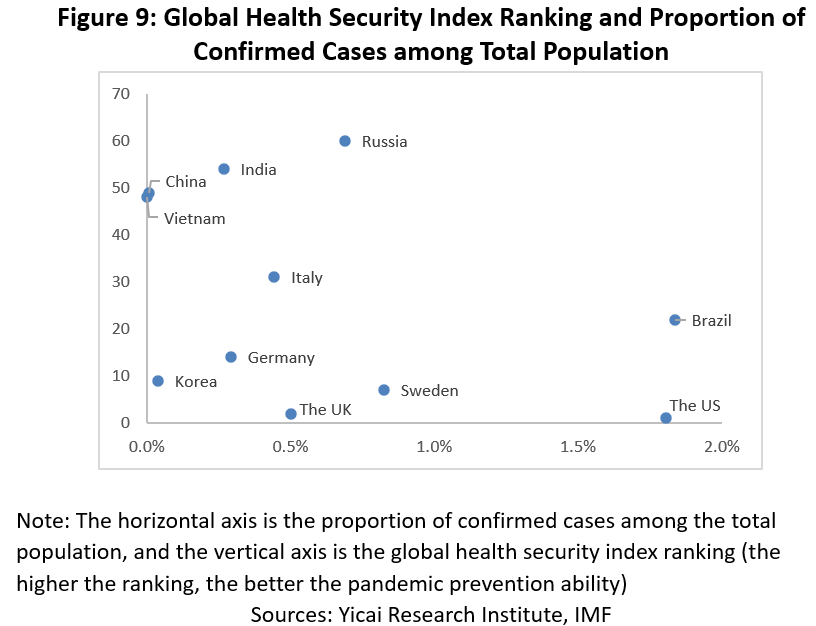
Vaccines are the key to overcoming the epidemic, and drug companies have stepped up research and development of these vaccines. As of early September, 33 out of 321 Covid-19 vaccines in development had started clinical trials. Of them, the most advanced ones have entered phase Ⅲ clinical trials and are expected to publish their results by the end of the year. It took several decades to research and develop vaccines for the hepatitis B virus, yet it has only taken a few months to do the same for Covid-19. This is because it has become a contest of strength among the world's scientific and technological powerhouses.
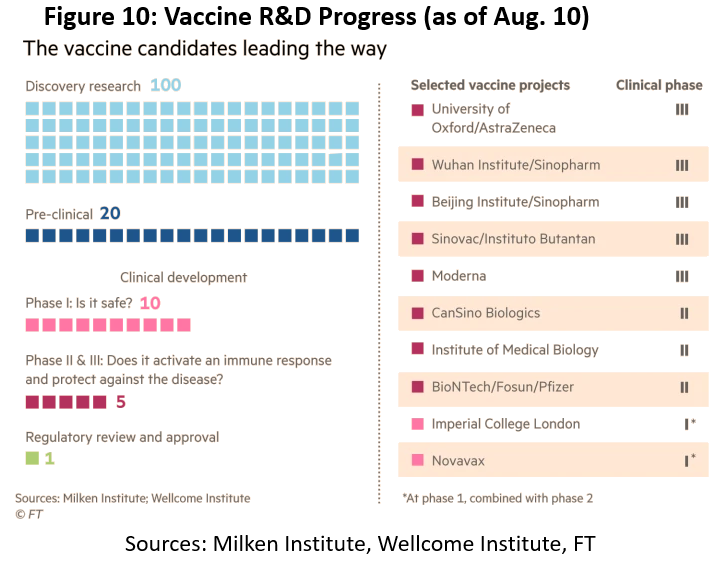
Governments have spent tens of billions of US dollars on Covid-19 vaccines and reserved some four billion doses with an uncertain delivery date. Goldman Sachs estimates that emerging markets can only cover less than a third of their citizens on average. Vaccine producers project that it will not be possible to inoculate everyone in developing countries until 2024.
5. Economic Bailout
The novel coronavirus had been detected in 215 countries and regions worldwide as of Aug. 31. The global economy will contract by 4.9 percent, a level comparable to the Great Depression in the early 20th century, according to an IMF estimate in June. In a previous severe global financial crisis in 2009, the world’s economy shrank by only 1.7 percent.
Economic activities have stagnated due to epidemic prevention policies, with the consumption and export-oriented sectors hit particularly hard. Forced or voluntary social distancing, economic blockades, declining incomes and weak consumer confidence have led to a significant decline in consumption and service sector output, a synchronized recession that resonates globally through trade.
Countries have launched unprecedented economic rescue packages to prevent economic collapse and subsequent humanitarian disasters. These measures include not only assistance to individuals (such as health insurance support, payments to low-income people and unemployment benefits), but also economic assistance programs for commercial enterprises (such as corporate credit support). Referring to the IMF’s classification method, we have identified three bailout measures.
A. Government Spending
Governments maintain the financial condition and liquidity of households and businesses by increasing public investments, providing industrial support funds and expanding unemployment benefits. The specific methods include:
B. Government Income
Governments are slashing social security contributions, deferring payments and reducing value-added taxes to ensure that households and businesses have adequate liquidity. Specific measures include:
C. Liquidity Support
Many individuals and companies around the world face a drop in income, unemployment or bankruptcy because of liquidity problems. In response, governments are providing cash flow support to companies and individuals through loans, guarantees and other forms of support. Specific measures include:
Of the major countries, emerging markets are spending less on the three above bailout plans than developed countries. China is less dependent on bailout policies thanks to its early containment of the epidemic and a lower level of economic recession.
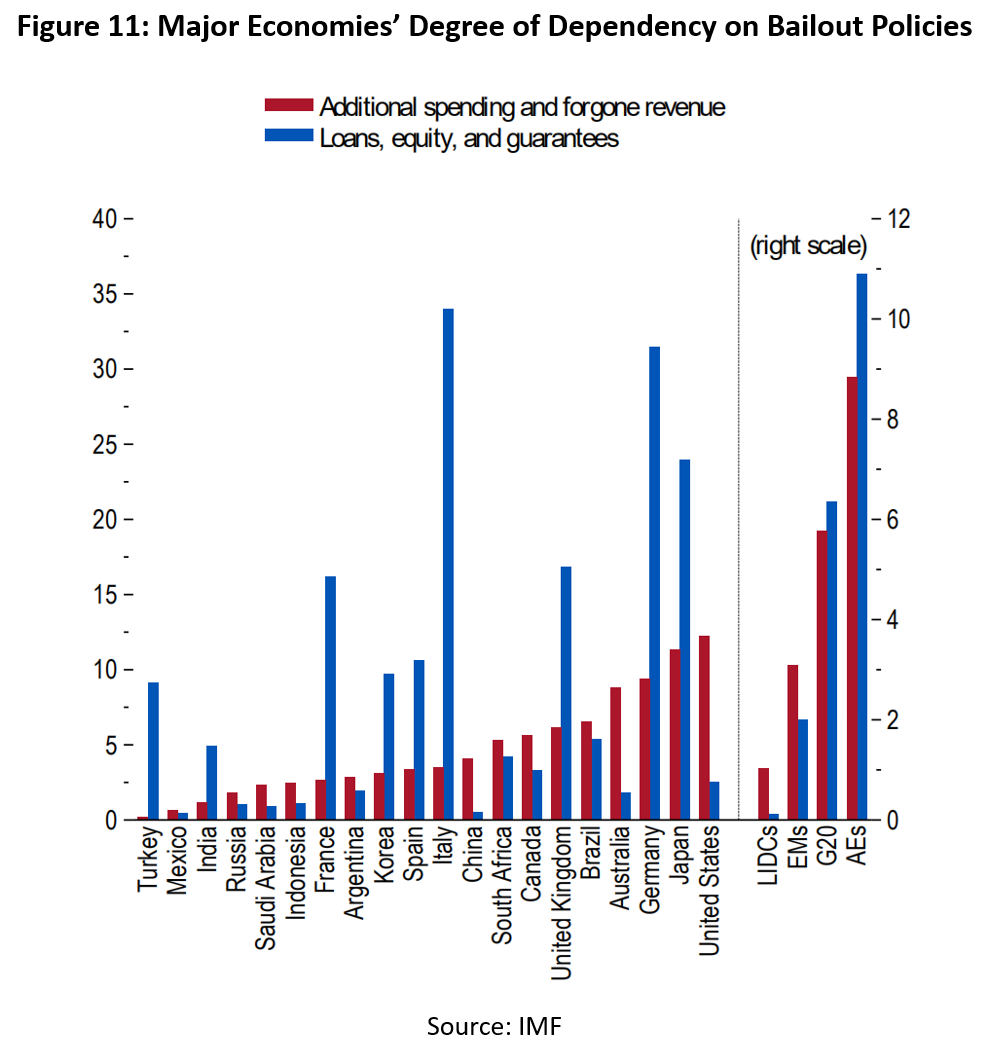
These relief policies will greatly worsen the financial situation of many countries. For those countries (mostly developed ones) whose public sector debt accounted for more than 100% of GDP before the epidemic, the pandemic relief measures will further restrict room for maneuver for future fiscal policies.
The fiscal deficit of all countries in the world this year will account for 9.9 percent of GDP, according to the IMF. The fiscal deficit rate of advanced economies will reach 10.7 percent. The deficit rates of the US, the Eurozone and Japan will be 15.4 percent, 7.5 percent and 7.1 percent respectively. The fiscal deficit rate of emerging market economies will reach 9.1 percent while China and India will each have deficit rates of 11.2 percent and 7.4 percent.

D. Quantitative Easing During the Novel Coronavirus Pandemic
As the global economy and financial markets have been seriously impacted by the pandemic, central banks in many countries have adopted unprecedented easing policies. For developed countries, quantitative easing has become a common monetary policy tool since the last global financial crisis. Central banks, including the US Federal Reserve and the Bank of Japan, have even introduced an "unlimited quantitative easing" policy that does not have an upper limit on the scale of quantitative easing. For emerging markets, many economies have adopted quantitative easing measures for the first time. On the day of announcing quantitative easing measures, the risk-free interest rates of emerging market economies fell even more than developed economies. The central bank balance sheet of the Group of Ten has reached a historic USD22 trillion, according to the IMF.
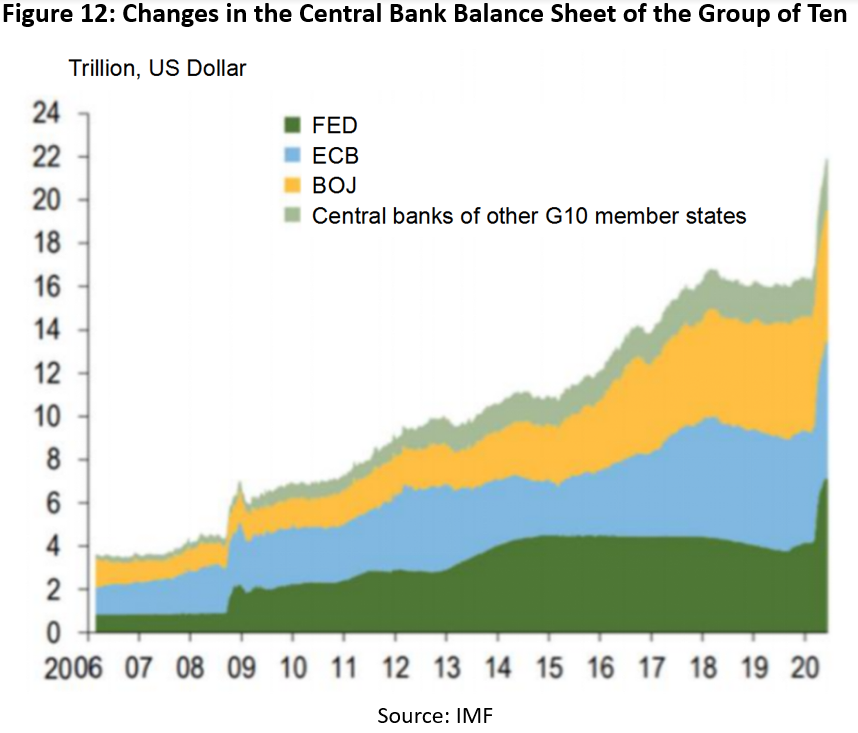
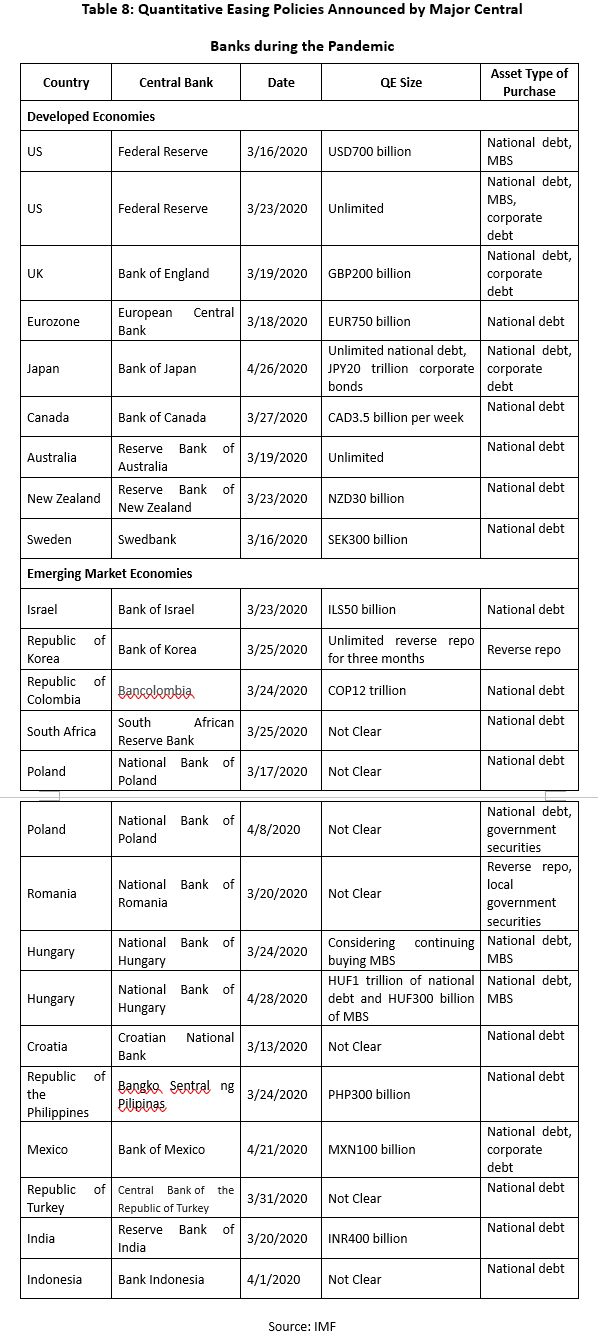
Pandemic control and economic relief are two sides of the fight against Covid-19. The goal is to help society get through this public health crisis more smoothly. Some believe that economic losses are the cost of fighting the epidemic, because strict social distancing policies will affect the economy from both the supply and demand sides. However, our studies do not support this view. The relationship between the two is not always the same. Countries with high epidemic prevention scores will suffer relatively less economic impact according to our assessment. If a country can quickly prevent the epidemic from spreading, it will reduce the lockdown period and thus reduce the impact on consumer confidence and lessen the economic fallout.
If we take China and South Korea as examples, both countries implemented strict epidemic prevention measures in the early stages of the outbreak and used advanced digital technology to carry out epidemic prevention policies. Both countries had the disease basically under control by March. The two countries then gradually got back to work and resumed production. The IMF expects the GDP of the two countries to only contract slightly this year. According to second-quarter economic data, China's economy has already resumed growth.
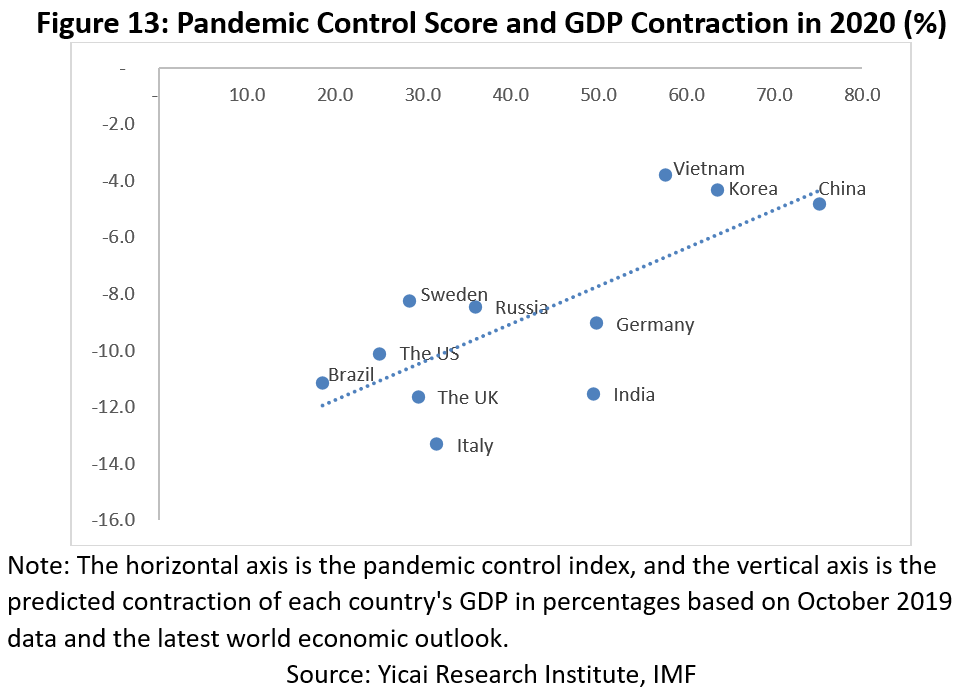
6. Economic Rebooting and Recovery
Governments’ policy focus and framework need to change as the goal shifts from pandemic control to rebooting the economy. For example, during the health crisis, the focus is to suppress the virus at all costs and dispense rapid economic assistance to companies and individuals. The main policy measures include tax relief, payments and other liquidity measures. In the economic recovery phase, as businesses get back to work and production gradually resumes, the focus is on how to manage virus transmission and provide structural support to specific industries. Specific measures include short-term stimulus policies, increased public investment and more structural measures to promote employment.
 Public health investment is very important considering the future state of the epidemic. The low-interest-rate environment provides an opportunity to implement proactive fiscal policies to support short-term demand, making public health investment profitable. One purpose of boosting investment in the public health sector is to ensure that public health resources are abundant, which will affect the return on investment in certain fields. In addition to increasing financial support for public health, the government can also use preferential policies to ensure that the private sector is willing to invest. The public health system focused on medical care rather than disease control in the past. This also needs to be changed. If we take China as an example, the number of medical workers jumped by 84.2 percent nationwide from 2008 to 2018, while those in the Chinese Center for Disease Control and Prevention fell by 5.4 percent over the same period.
Public health investment is very important considering the future state of the epidemic. The low-interest-rate environment provides an opportunity to implement proactive fiscal policies to support short-term demand, making public health investment profitable. One purpose of boosting investment in the public health sector is to ensure that public health resources are abundant, which will affect the return on investment in certain fields. In addition to increasing financial support for public health, the government can also use preferential policies to ensure that the private sector is willing to invest. The public health system focused on medical care rather than disease control in the past. This also needs to be changed. If we take China as an example, the number of medical workers jumped by 84.2 percent nationwide from 2008 to 2018, while those in the Chinese Center for Disease Control and Prevention fell by 5.4 percent over the same period.
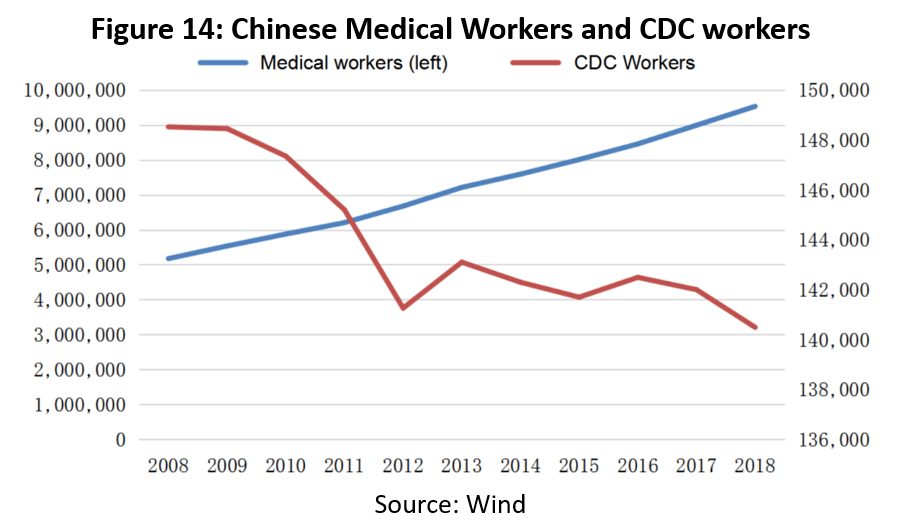
7. International Cooperation
The pandemic has made international cooperation vital. Global problems including the pandemic can only be solved with effective and strong international cooperation. Many countries chose to tighten export controls during the epidemic. However, due to the high scarcity of epidemic control supplies amid the rapid spread of pandemic, this led to the suspension and disruption of global supply chains. Our study examined the performance of countries assisting others in fighting the epidemic, including providing financial assistance and restricting exports of medical supplies. China has performed well in this area due to its strong manufacturing capabilities and early control of the epidemic.
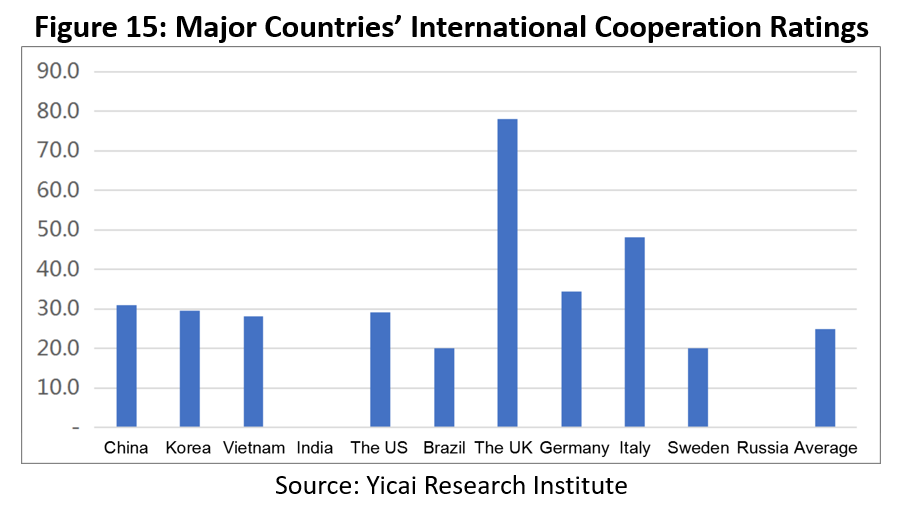
Our assessment reviewed countries’ donations to the World Health Organization’s COVID-19 Solidarity Response Fund, which shows how active countries are in international cooperation. From this perspective, most countries’ performance is basically in line with their economic scale. The only exception is the United States, which has quite a low score in this area. The US notified the United Nations on July 6 of its intention to formally withdraw from the WHO and end its 72-year membership.
International cooperation amid the Covid-19 pandemic also includes the following fields:
In brief, the Covid-19 pandemic will coexist with mankind before effective vaccines can be widely put into use. Effective governance that responds quickly using technological means and which can depend on public support is an effective strategy to deal with the pandemic. Covid-19 will eventually pass, but more epidemics will follow. Large-scale investment in public health is the only way to respond to and prevent future epidemics. Meanwhile, global policymakers have introduced economic and financial policies of unprecedented intensity and scale due to the economic fallout and the great recession caused by the epidemic, which will profoundly affect the future. National and public governance capabilities, economic growth momentum and resource mobilization capacity are key to determining the future strength of nations.
Editor: Yang Yanqing
Advisor: Li Wenlong
Data compiling/processing and writing: Lin Chunjie, Ma Shaozhi, Liu Xin, Mark Kruger, Shao Yurong, Yan Fangjia, Zhang Shiming, Zhang Guoli.